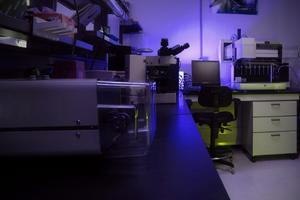The Department of Mechanical Engineering at the University of Houston Cullen College of Engineering has nearly completed the renovation of its Biomedical Engineering Core Research Lab.
The renovation of the lab was spearheaded by Mathew Franchek, chair of mechanical engineering and the director of the Biomedical Engineering Program. The new lab will provide faculty in the program with equipment and space to conduct advanced research in this emerging field. In addition, biomedical engineering students will benefit from the interactive educational environment provided by the lab.
The overall design of the facility was generated by two of its principal investigators: Daniel Martinez, associate professor of biomedical engineering and the lab’s director; and Kirill Larin, assistant professor of biomedical engineering and director of the Biomedical Optics Laboratory.
“We morphed the lab into a state-of-the-art biochemistry, molecular biology, cell biology laboratory,” said Martinez, who is also an associate professor of health and human performance in the university’s College of Education. “The equipment we have in the lab will go a long way in establishing credibility for the program, and therefore, open up new doors for funding opportunities.”
The newly purchased equipment for the lab includes a cell culture facility with biosafety cabinets and carbon dioxide incubators, which is used to conduct in vitro experiments, and a microarray scanner used to analyze thousands of genes at a time.
Basic renovations in the lab include adding flooring, ventilation hoods, lighting, walls, and lab benches. In addition, roughly $600,000 worth of equipment was moved from the Connective Tissue Physiology Laboratory into the new facility.
In addition to serving as a research area, the lab will be used to teach a senior-level bioanalytics class. This course will present undergraduate students with a survey of bioanalytical methods used in research and industrial laboratories. “The class is going to involve hands-on activities and a lot of show and tell,” said Martinez, who is teaching the course. Students will learn the principles of operation and instrumentation for both traditional methods, such as electrophoresis, spectroscopy, and chromatography, as well as modern high-throughput methods, such as microarrays.
Ultimately, one of the biggest advantages of the lab, said Martinez, is that it will encourage collaboration across scientific disciplines.
“The lab is really a place that individuals with similar interests will have the ability to work and research with state-of-the-art biomedical equipment,” he said. “This is one of the first places on campus that this is happening.”
